How Seoul Metro Installed Platform Screen Doors Everywhere
The political history of a safety equipment
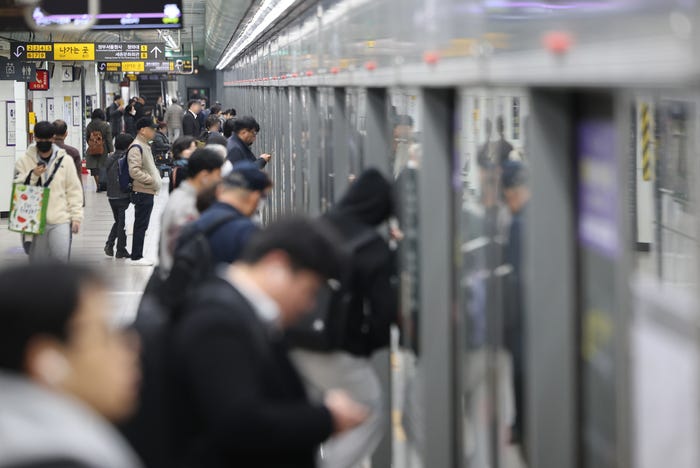
Riding the Seoul Metro this summer for the first time in 25 years, the most visceral change I noticed was the ubiquity of platform screen doors between me and the tracks. I noticed them alertly, for I remember how deathly afraid I was of falling over into the tracks as a child. Usually one grows out of or overcomes their childhood fears; standing on the edge of the platform, peering through the glass wall, I realized my fear, at its site of origin, had been made physically impossible, now a concern no child in Seoul would share.
How did Seoul do it? As with the focus of this blog, it all comes back to the politics and the hinge points which catalyze political action. Seoul did not build its platform screen doors (PSDs) out of some Confucian duty or because of the better angels of Korean nature (in this house, we reject Orientalist flattery and overwrought cultural essentialisms!) but through its own grinding political process, through crises in Seoul and South Korea’s tempestuous 21st century history.
Seoul Metro in the early 2000s experienced the same issues many metros in cities around the world experience to this day: an alarming frequency of deaths and injuries due to people falling onto its tracks. Platform screen doors were entertained briefly between 2000 and 2002 but went nowhere until two events in rapid succession in 2003 greatly shook the country: a fire inside a metro station in the city of Daegu which killed 192 people in February and a subway-pushing murder at a Seoul Metro station in June. These two events led to a widespread feeling of panic and unsafety at metro stations across South Korea. Even then, as platform screen doors were hailed as a solution, local politicians haggled and argued over their feasibility, cost, and effectiveness. The political stalemate was broken, unexpectedly, over another public safety issue – clean air – which suddenly shook up the value of PSDs and made them too valuable to leave behind as a failed pilot project.
The fine details in this short history – spanning 2003 and 2015 – underscore how much initial resistance and uncertainty there was to installing PSDs in Seoul. It can be argued that, at the beginning, two men alone kept the possibility of PSDs alive: the mayor of Seoul and the widower of the woman murdered in the subway-pushing incident. PSDs’ position was never guaranteed – until it was, and then it was as if PSDs were the most natural thing in the world. These decision makers could never have imagined their PSDs would be equipping every metro station in South Korea in less than 20 years’ time. Perhaps, with some optimism, readers can imagine such a banal history happening in their own city.
Author’s Note
This post would not have been possible without the 2016 paper “An Analysis of Restriction of Access to Means of Suicide Policy Process: The Case of Platform Screen Doors in Seoul City’s Subway System,” published by Jeong Duyong at Seoul National University’s Graduate School of Public Health. I found it to be an illuminating research paper that delved deep into the political formation of platform screen doors in Seoul.
I also would like to thank Katharine Khamhaengwong for editing this story. Please follow her at @katharinegk.bsky.social.
You can help support my work at S(ubstack)-Bahn by putting some money in the Ko-fi tip jar.
Disaster Republic
One can chart the course of South Korea’s history after the end of the devastating Korean War in 1953 by a chain of large-scale accidents, which killed and injured hundreds of civilians. South Korea’s breakneck industrialization and urbanization from the 1950s to the 1980s made accidents a regular occurrence. But these accidents did not transmute into forms of national trauma until after democratization in 1987, when freedom of speech and press was opened after decades of dictatorial censorship and the country reached the status of a developed nation, heralded by the 1988 Seoul Olympics. The country’s citizens had come to expect a higher quality of life, and they were no longer afraid to speak out.
The 1990s was a time of whiplash: the Korean economy ran red-hot until its spectacular crash in 1997; shiny new buildings, roads, planes, and boats also crashed, with horrifying casualty figures. Mass casualty accidents piled up as the decade progressed, and citizens began calling their new democratic country the “disaster republic.” These accidents included:
the Mugunghwa train collision in March 1993 (78 dead),
the Asiana plane crash at Mokpo in July 1993 (68 dead),
the sinking of the MV Seohae ferry in October 1993 (292 dead),
the Seongsu Bridge collapse in Seoul in October 1994 (32 dead),
the Daegu Metro construction explosion in April 1995 (101 dead),
the Sampoong Department Store in Seoul collapse in June 1995 (502 dead),
the Korean Air crash in August 1997 (228 dead), and
the Sealand Children’s Camp fire in June 1999 (23 dead).
Beyond the witty moniker, Korean society was left deeply traumatized by this succession of accidents. A shared feeling that nowhere was truly safe – considering so many buildings, roads, and bridges were built in the same rapid, unregulated manner – pervaded nationwide. As a child growing up in 1990s Korea, I can speak personally: these disasters were some of my first memories, and I vividly recall learning about the Seongsu Bridge collapse and especially the Sealand fire, where 18 of 23 victims were children aged 5 to 7 – my age then – found huddled together in the same room after the fire engulfed the building.
(The accidents slowed in frequency over time but the shockwaves never went away. The sinking of MV Sewol ferry [476 dead] in April 2014 and the Itaewon crowd crush [159 dead] on Halloween night in 2022 re-traumatized the country and have galvanized, and polarized, Korean politics since. The current president, Lee Jae-myung – who is partially disabled from a machinery accident which crushed his arm as a teenage factory worker – seems to have made it his crusade to dole out heavy punishments on any company with a record of on-site fatalities or casualties.)1
This background is critical in understanding the political environment that helped usher in platform screen doors. The Daegu subway fire of February 18, 2003, shocked an already traumatized nation due to its gruesome and preventable nature. The arsonist, a taxi driver in his 50s who had lost his job due to a stroke, entered a Daegu Metro train at 9:53 am with a lighter and two cartons of flammable liquid. After wrestling with passengers trying to stop him, he lit one of the cartons. The fire spread through all six cars of the train within minutes; the cars were lined with polyurethane foam and furnished with vinyl seats and plastic matted floors – all flammable materials. The train operator failed to immediately alert officials, and another train pulled into the underground station next to the burning train heading in the opposite direction. The second train soon caught on fire. The operator for the second train fled without providing passengers a way to escape, trapping them to their deaths. One hundred ninety-two passengers died and 151 were injured.
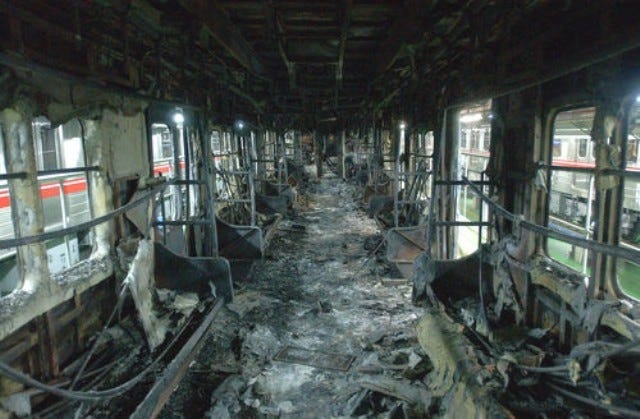
Four months later, at 10:07 am on June 22, a 42-year-old woman, Ahn Sang-ran, was waiting for a Seoul Metro’s Line 4 train at Hoehyeon Station. She had finished her all-nighter business at Namdaemun Market and was heading to another market to buy fabric. As a Line 4 train pulled in, a man in his 50s randomly pushed Ahn onto the tracks as a train approached. Ahn died immediately. Her husband, Yoon Byung-so, was the chief detective of the Seoul Metro Police Department, based at the far busier Jongno-3-ga Station. He learned on the job that he lost his wife in his jurisdiction and now was left to raise three young children without their mother.2
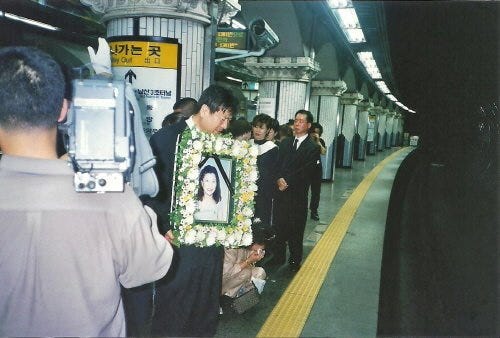
Mission Impossible
In 2003, Seoul Metro registered 85 accidents on its tracks, resulting in 52 fatalities – of which Ahn was one – and 31 severe injuries. This was a notable increase from the 139 fatalities recorded on the tracks between 1998 and 2002, 91 of which were suicides.3
Seoul Metro had explored platform screen doors already – but only in the last year, for the under-construction Line 9.4 In negotiations with private construction partners in Seoul’s first and only privatized line, Seoul Metro demanded platform screen doors on all Line 9 stations.5 For the already-operating Lines 1 to 8, the Seoul Metro’s labor unions had demanded PSDs prior to the Line 9 settlement, but management determined it would be too hard and too costly to retrofit operational stations. However, in preparation for Line 9, Seoul Metro management tested a PSD prototype at Singil Station in 2003, where Lines 1 and 5 operate.
The prototype started as a half-enclosed door, open from chest-level upwards, before a second floor-to-ceiling door prototype was installed the next year . During the Singil pilot, its construction chief reported to the Seoul City Council that he thought PSDs might be a waste of extremely limited capital funds. He suggested safety fences – metal grated fences at about waist height along the platform edge, with openings for doors – along the platform as a better, cost-friendly alternative; the now familiar Seoul Metro PSD, of giant, hermetic glass panels and sliding doors, was still in gestation.6
As Metro management shuttered its interest in PSDs, widower Yoon soon began pushing the agenda that PSDs would have saved his wife’s life to the media. He petitioned directly to the Seoul Metro to install PSDs at its stations and floated the possibility of a lawsuit against Seoul Metro. But he acknowledged in his petition that he faced incredible odds:
[Seoul Metro] tells me coldly that installing platform screen doors at stations is impossible as they do not have the funds and the engineering skills in South Korea are lacking. … I have visited several lawyers but they all turned me down. They say if I sue it will be dismissed. They say there is no gain.7
Politicians were divided on feasibility. While some were supportive, many on the city council dismissed a system-wide PSD installation plan based on cost and lack of domestic expertise in installation. PSDs were initially estimated to cost between 2 billion and 3 billion won (approximately US$1.8 million to $2.6 million) per station – and more than 500 billion won for all 250+ Seoul Metro stations.8 If completed, this would increase Seoul Metro’s existing construction debt of 1.6 trillion won by nearly a third. For management, this was repellent. Besides, it was unclear if anyone could build it for that price. Once, the city council asked Seoul Metro staff how many firms in South Korea could even do the installation work; they said one – and a dubious company at that.9
Those against PSDs repeatedly said they were economically “impossible.” Internally, policymakers and bureaucrats in the Seoul Metropolitan Government echoed the sentiment:
Economists and experts ask if there is a need to install platform screen doors considering its huge expenses and lengthy construction periods. If there is an accident, [the Metro] can compensate. … Even in the United States, systems like the New York City subway have not installed one over its 100-year history.10
Despite the price tag scare, the debate over PSDs rolled over into 2004 due to the continued interest of four unconnected parties: first, the widower Yoon, whose media campaign was in full steam; second, the labor unions who had over the years demanded PSDs for passenger and employee safety; third, Seoul Mayor Lee Myung-bak, who, in January 2004, jumped into the debate by asking his own staff to look into PSD feasibility; and, lastly, a cadre of councilmembers who periodically quizzed Seoul Metro management about PSDs.11
The last two held the most sway. Mayor Lee, a former Hyundai Engineering and Construction CEO, was arguably the most consequential Seoul Mayor in modern history, most famous for tearing down the Cheonggyecheon freeway and restoring the creek that ran below it. Lee, who often took the metro as mayor, was greatly interested in transforming Seoul’s transportation network and led the consequential 2004 bus network reorganization.12 The PSD plan was thus in Lee’s wheelhouse: a large-scale construction project to remake Seoul’s urban transportation fabric. One anonymous Seoul Metro employee told the press that despite the council’s majority opposition to PSDs, Lee kept the issue alive by sheer will and personal interest.13

Those aligned with Lee in the city council approached the issue from a different emotional source – anxiety and trauma. The Daegu subway fire was constantly on their minds as they talked about PSDs. One councilmember said, “citizens are at a point where they cannot shake off the anxiety in their everyday life and are in a state of panic.” Another said “after [the Daegu subway fire], little accidents in Seoul Metro since have continued the stress and fear within Seoul residents.”14 It reached a point where politicians felt pressed to do something, anything, to allay the nerves.
New Wind in its Sails
This rudderless, ragtag group of supporters tasted its first victory in February 2004, when the Seoul city council decided to explore a pilot platform screen door program funded entirely by private investments (in return for turning PSDs into new advertising space). The pilot was, however, uninspired and conducted with little urgency – it would take 20 months for the first PSD pilot to be installed at Sadang station in October 2005.
Meanwhile, local politicians and bureaucrats continued pushing for PSDs by highlighting benefits beyond safety, such as reduction of noise levels, lower fine dust levels, and retention of air-conditioned cooling on the platform.15 But detractors poked holes at the central supporting tenet for PSDs, which was whether they are effective at preventing fatalities on the train tracks. Politicians cast doubt on PSDs ability to meaningfully reduce or prevent suicides. Their opinions coalesced along a rather crude line of reasoning, as expressed by a city councilmember against PSDs:
Let’s say we installed PSDs everywhere to prevent suicides, but these people who want to kill themselves will kill themselves elsewhere. Do you understand what I mean? There are more people who throw themselves to death at the Han River. Shall we install PSDs on every bridge on the Han River too? … The subway’s budget is already so tight, and this is not the way to spend money.16
But in 2005, the beleaguered pro-PSD movement gained new momentum with support from an unexpected source. Seoul's environmental bureau threw their hat in the ring to loudly back PSDs as the key to combating a growing public health hazard: air pollution. Seoul Metro stations then recorded very high levels of fine brake dust on their platforms. When trains brake, their steel wheels spark off microscopic particulates and blow them into the air. This brake dust includes iron, manganese, and cadmium at levels well over recommended exposure levels and continuous exposure at high levels is associated with higher rates of cancer and respiratory, cardiovascular, and neurodegenerative diseases.17 Seoul’s environmental chief reported in November 2005 that the Sadang pilot PSD had reduced fine dust levels by half, a shocking success. As a measure to safeguard public and environmental health, the environmental chief thus argued, PSDs must be installed systemwide, through private investment, public subsidies, or by any other possible means.18
The twin crusade of public safety (reduction of train collision fatalities and injuries) and public health (reduced exposure of carcinogenic dust) made the case for PSDs far stronger and more palatable to politicians with power of purse. At the same time, the Seoul Metropolitan Government (SMG) and Seoul Metro’s difficulties finding a suitable private bidder for the pilot PSDs cemented the understanding that some level of public support would be necessary. In 2005, the SMG approved a budget of 10 billion won to install PSDs at 28 Seoul Metro stations by the end of 2006. Despite the figure, that was only enough to cover 15% of the cost for the 28 stations; half of the funding was to come from public-private partnerships and the remaining 35% from Seoul Metro’s own pockets.19
PSDs were undoubtedly on the rise, and their destiny as part of Seoul Metro was sealed on December 28, 2005. The incident that cemented their place was not a council vote or an executive order of the mayor but a verdict at the Seoul High Court. The widower, Yoon Byung-so, had sued Seoul Metro in 2004 and, surprisingly, won his case at the Seoul Central District Court, which ruled the corporation bore responsibility for his wife’s death. Seoul Metro appealed, but, on December 28, the Seoul High Court sided with the lower court’s opinion. Yoon was compensated 220 million won in the High Court verdict.20 Of greater consequence was the precedent set in South Korea: if a person falls off the platform and is killed by a train, whether as an act of suicide or by accident, the train corporation does bear some responsibility for their death. Seoul Metro was now exposed to future liability in similar accidents or suicides (or murders). The corporation took the ruling as “an administrative order” that stations would need to be death-proofed, regardless of cost.21
The Clean Air Mayor
Before his term ended in 2006, Mayor Lee Myung-bak announced he would not run for re-election, in order to focus on the presidential election the next year. Lee’s swashbuckling mayoralty transformed the urban landscape and transportation of Seoul in ways no predecessor had; his outsized legacy as the “CEO mayor” of Seoul ushered him first as the conservative Grand National Party presidential candidate and then into the Blue House in 2007 as the 10th president of South Korea.22 (After his presidency, Lee was convicted of bribery and embezzlement and spent four years in prison.) Lee had a chosen heir for Seoul mayor: the telegenic 45-year-old lawyer-turned-politician Oh Se-hoon. Like Lee, Oh sought to remake areas of Seoul’s civic life to his own specifications. Lee had targeted transportation and urban spaces; for Oh, it became clean air.
Seoul’s air pollution problem had been growing since the 1970s, reaching its peak in the 2000s. Seoul was then replete with heavy industry, including factories within city limits, and fostered a growing middle class buying and driving increasing numbers of cars. In 2006, Seoul’s outdoor fine dust levels, at 61 µg/m3 (micrograms per cubic meter), were twice as high as Tokyo’s and thrice as high as in New York City and Paris; underground Seoul Metro stations were far worse, recording levels as high as 150 µg/m3.23 Smog was a familiar filter, covering the Seoul skyline year-round. Air pollution would reach its apex in springtime, when yellow dust from the Gobi Desert would push east and fill the sky for weeks.
When Oh was elected mayor in July 2006, he promised a ten-point “Clean Seoul” agenda to reduce air pollution, including restrictions on old diesel vehicles and installation of emission filters in diesel vehicles.24 One of his most ambitious promises was tucked inside his eighth point: combat fine dust in underground spaces, especially Metro platforms. There, Oh proposed to do something that until his election seemed not only impossible but implausible: install platform screen doors at all 265 Seoul Metro stations by 2010, the end of his first term.
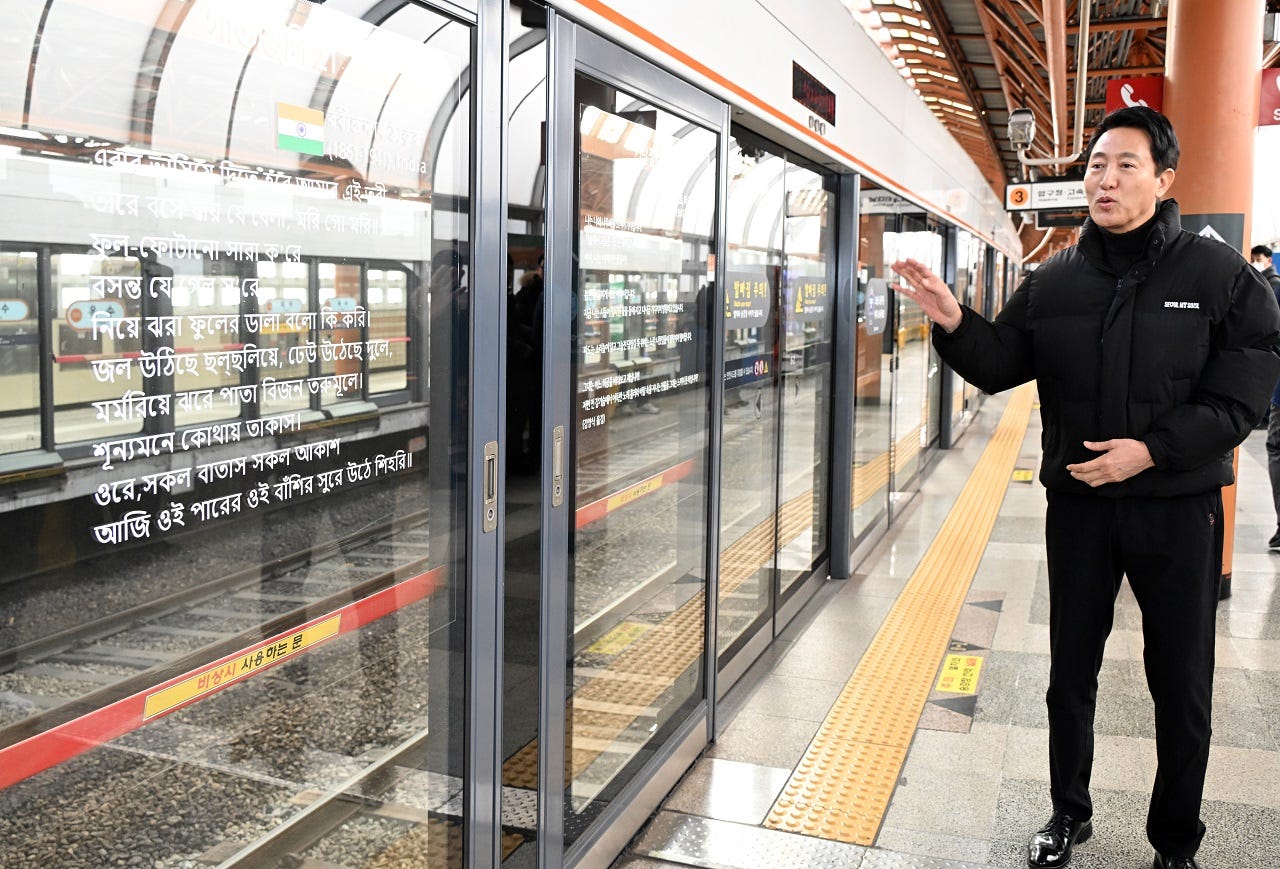
By the end of 2006, PSDs had been installed in 18 out of the 28 stations approved by the SMG in their 2005 budget.25 SMG staff noted encouraging benefits, invisible to the naked eye, brought by the PSDs: the average fine dust levels at these stations dropped from 131 µg/m3 to 85 µg/m3 – a 35% drop, and the average noise volume dropped 8%, from 78.3 db(A) (weighted decibels) to 72.1dB(A).26 With this data, Oh promoted PSDs as a pillar of his ambitious “Clean Seoul” agenda. Like with Lee, Oh’s vocal support made it difficult for local politicians to push back on PSDs.
Unlike in 2004, when the SMG sought private contractors to pay for and build the test PSDs, the city was determined to pay for this project using public funds. For the SMG and Seoul Metro, they wanted nothing more to do with private operatorship after an arduous initial pilot process. Low bids from companies with no technical expertise had slowed the project. Some companies even went bankrupt in the middle of construction.27 Ironically, the rough lessons from the pilot helped iron out technical issues with later PSDs and taught the SMG, Seoul Metro, and the surviving private contractors valuable lessons on how to build more reliable PSDs at scale.28
In September 2006, the Seoul Metropolitan Government’s transportation bureau calculated the remaining cost to install at all Seoul Metro stations at 400 billion won (approximately US$420 million).29 The transportation bureau proposed to Seoul Metro that it would fund 20 billion won annually from 2007 through 2010, with the remaining costs paid by Seoul Metro.30 In December, this funding plan was approved by the Seoul city council and Mayor Oh.
Going National
On December 31, 2009, the last of the platform screen doors was installed. All 265 Seoul Metro stations for Lines 1-8 sported PSDs – a year ahead of schedule. That night, former Metro police officer Yoon Byung-so stood where his wife was pushed to her death at Hoehyeon station, now blocked from the tracks by a PSD. “Rest up now dear, don’t worry about the kids now,” said the teary-eyed Yoon.31
Literature or videos on the three-year PSD installation project were not available online, which casts a fog on how they were able to install so quickly. But we can take some educated guesses. First, as mentioned above, the hard technical issues of PSDs had long been ironed out, thus making it easy to procure for the SMG and Seoul Metro and for the contractors (Hyundai Movex and Samjung Tech built the vast majority of Seoul Metro PSDs) to build at scale. Second, Mayor Oh’s interest in seeing the project completed before the end of his term in 2010 likely played a part. Third, all Seoul Metro rolling stock measurements are standardized and identical – the train cars all have the same length, width, and height, as well as four doors on each side – for a fast and easy installation process.32
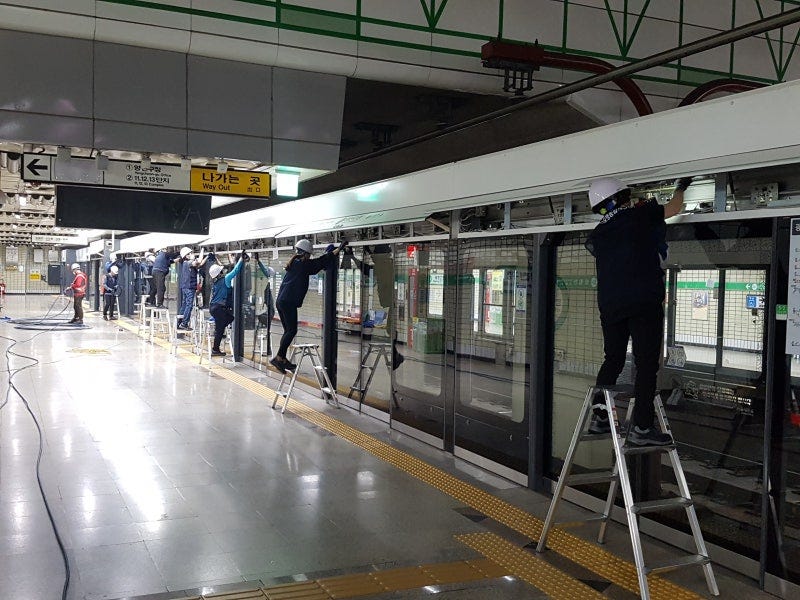
Since its completion, Seoul Metro’s full PSD enclosure has delivered all its supporters promised – and more. Most crucially, track fatalities vanished overnight. Between 2001 and 2009, about 37 people died in Seoul Metro right-of-way annually on average, 34 of which were determined as suicides.33 Since 2010, fatalities in Seoul Metro have come in at 0.5 per year, with 0.1 determined as suicides. (Between 2012 and 2022, no suicide-determined fatalities occurred.) Fine dust levels averaged around 80 µg/m3, as observed in the pilots. Seoul Metro reported it saved 30% on energy prices during the summer months thanks to PSDs.34
The immediate success of Seoul Metro’s PSDs spurred action to codify them as an essential part of the South Korean transit fabric. Since the project’s inception in 2007, all subsequent Seoul Metro stations have been built with PSDs already in place. Starting in 2012, Busan Metro, the country’s second largest system, began installing their own PSDs.35 In 2015, the National Assembly amended the Rail Safety Act to include that railway operators must install PSDs at all rapid transit station platforms, new or old.36 Following the 2015 amendment, all other metro systems in South Korea retrofitted their stations to include PSDs.
Sliding Doors Moment
In South Korea at the time of this post’s publication, there are 708 train stations that serve mass rapid transit operations.37 All of them have platform screen doors, a stunning achievement for a country which 20 years ago had one operational PSD, at Singil Station. In fact, PSDs have now been around long enough that the Seoul and Busan metros have replaced their entire stock since deployment.38 And, thanks to the 2015 amendment of the Rail Safety Act, this full compliance is guaranteed for all stations to come.
As noted above, Seoul Metro’s push to equip all stations with PSDs provided the technical expertise and experience for companies like Hyundai Movex and Samjung Tech to be able to build PSDs at scale. Clear government-led regulations and promotions have eased procurement and construction to the point where PSDs have been absorbed as a natural part of a metro station. New technologies have been proposed to herald the next generation of PSDs in South Korea, such as transparent OLED glass screens produced by LG that will show live subway maps and safety information.39 Creating engaging platforms does not require cutting-edge technology; Seoul Metro holds an annual competition for rider-submitted poems to fill up unused glass panel space.40
It would be inaccurate to characterize the full implementation of PSDs as perfect. Between 2012 and 2016, six fatalities occurred in Seoul due to accidents related to PSDs. Three fatalities were passengers caught between the screen door and the departing train.41 Another involved a 19-year-old mechanic who was struck by a train while repairing a broken PSD sensor from the track side. Later revelations found the mechanic was dispatched to work alone – despite rules requiring the presence of two people for PSD inspections – and gained Seoul Metro public ire, especially from labor activists.42
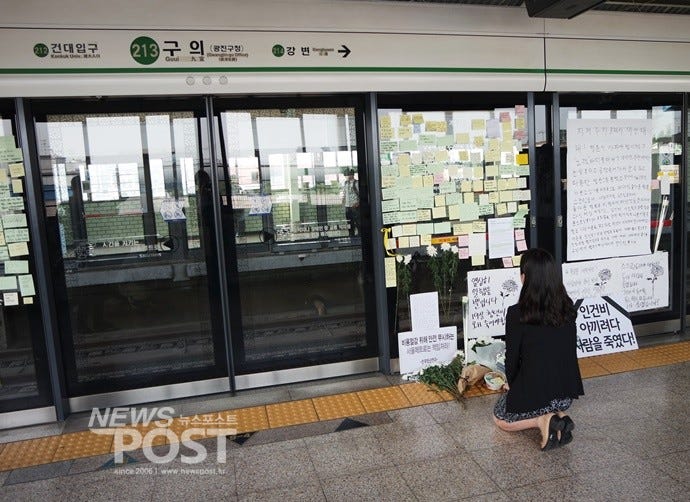
Tragedies have dotted modern South Korean history both before and after the installation of PSDs. Just as these terrible deaths were not predestined, nothing about the arrival of PSDs was either. It took the confluence of several societal conditions – including the trauma of the Daegu subway fire, which continues to actively shape emergency safety planning in South Korea to this day – and men like Lee Myung-bak and Yoon Byung-so, men shaped by their times and experiences and traumas, to materialize PSDs into a nigh-invisible object encountered daily, if not hourly. For the outsider looking in, these doors may as well be transit magic; for the insider, however, the platform screen door looks more like a mere child of its times growing up in the Disaster Republic.
https://www.koreatimes.co.kr/business/companies/20250812/justice-or-overreaction-presidents-war-on-industrial-accidents-causes-stir
https://www.chosun.com/site/data/html_dir/2009/12/30/2009123001614.html
Jeong, Duyoung. “An Analysis of Restriction of Access to Means of Suicide Policy Process: The Case of Platform Screen Doors in Seoul City’s Subway System.” Department of Health Policy and Management The Graduate School of Public Health Seoul National University, 2016., P. 3
“Seoul Metro” at the time was two corporations: the Seoul Transportation Corporation, which operated Lines 1-4, and the Seoul Metropolitan Rapid Transit Corporation, which operated Lines 5-8. They merged into Seoul Metro in 2017. Based on my research for the story, there was little to no divergence between the two corporations. For simplicity’s sake, I will call them “Seoul Metro” throughout this post.
Jeong, P. 25
Jeong, P. 40
Jeong, P. 38-39
Jeong, P. 46; This calculation was based on a 2004 KRW:USD exchange rate of about 1,150 KRW per 1 USD
Jeong, P. 49
Jeong, P. 46
Jeong, P. 54-56
https://www.seamlessbayarea.org/blog/2025/5/5/notes-from-korea-how-bus-reforms-and-fare-integration-transformed-seouls-transit-bs2yk
Jeong, P. 55
Jeong, P. 53
Jeong, P. 62-63
Jeong, P. 60
Jeong, P. 13
Jeong, P. 69
Jeong, P. 71
Jeong, P. 72
Jeong, P. 73
https://www.pressian.com/pages/articles/88865
https://www.seoul.co.kr/news/Seoul_In/seoul_metro/2006/06/23/20060623216002
Jeong, P. 75
Jeong, P. 76
Jeong, P. 85
Jeong, P. 71
Jeong, P. 84-85
This calculation was based on a 2006 KRW:USD exchange rate of about 950 KRW per 1 USD
Jeong, P. 26
https://www.chosun.com/site/data/html_dir/2009/12/30/2009123001614.html
https://en.wikipedia.org/wiki/Seoul_Metropolitan_Subway_rolling_stock
https://www.mk.co.kr/news/society/10847721
https://www.khan.co.kr/article/202501122043025
https://www.busan.com/view/busan/view.php?code=20121113000143
https://lbox.kr/v2/statute/%EC%B2%A0%EB%8F%84%EC%95%88%EC%A0%84%EB%B2%95/%EB%B3%B8%EB%AC%B8%20%3E%20%EC%A0%9C4%EC%9E%A5%20%3E%20%EC%A0%9C25%EC%A1%B0%EC%9D%982?statuteName=%EC%B2%A0%EB%8F%84%EC%95%88%EC%A0%84%EB%B2%95&statuteType=%EB%B2%95%EB%A5%A0&effectiveDate=2025-01-31&proclamationNumber=%EC%A0%9C%2020763%ED%98%B8&proclamationDate=2025-01-31&revisionType=%EC%9D%BC%EB%B6%80%EA%B0%9C%EC%A0%95
289 Seoul Metro stations; 20 Gwangju Metro stations; 91 Daegu Metro stations; 108 Busan Metro stations; 65 Incheon Metro stations; 15 Uijeongbu Light Rail stations; 21 Busan-Gimhae LRT; 15 Yongin Everline; 10 Gimpo Goldline stations; 63 Suin-Bundang Line stations; 11 Sillim Line stations; 11 GTX-A stations
https://english.seoul.go.kr/smg-replace-entire-subway-platform-screen-door-sensors/; https://www.ajupress.com/view/20220304141058100
https://news.lgdisplay.com/en/2025/05/worlds-first-lg-displaystransparent-oled-installed-on-seoul-subway-platforms/
https://www.poetryfoundation.org/poetry-news/84662/in-south-korea-poetrys-everywhere
https://www.yna.co.kr/view/AKR20161213169000004

What I find more unusual is that even a lot of newly-built or refurbished intercity rail stations have PSDs, which is something I haven't noticed about such railways in other countries. The implementation of them can seem a bit less than elegant, leaving an odd gap between the top of the PSD and the station's roof/ceiling; it seems like the next logical step is to have fully-enclosed platforms as part of the station building, but that seems to me a bit of a loss, both in terms of some potential energy efficiency via natural ventilation (in above-ground stations) and, a bit more subjectively, atmosphere and ambience. However, the safety benefits are undeniable in this case, too, as is energy efficiency at least during Korea's sweltering summers and freezing winters.
Great post as always.
It seems like a huge barrier (pardon the pun) to the NYC subway building PSDs has been that the platform edges cannot support the weight of the doors. Do you know if Seoul faced a similar obstacle and how they solved it?